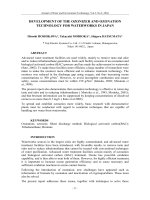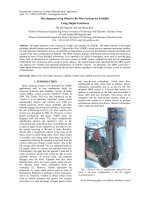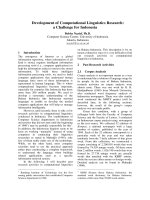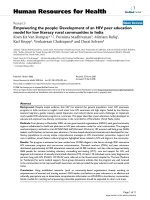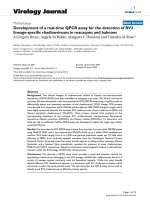Development of pneumatic metering experimental test rig for groundnut
Bạn đang xem bản rút gọn của tài liệu. Xem và tải ngay bản đầy đủ của tài liệu tại đây (217.6 KB, 7 trang )
Int.J.Curr.Microbiol.App.Sci (2019) 8(9): 1397-1403
International Journal of Current Microbiology and Applied Sciences
ISSN: 2319-7706 Volume 8 Number 09 (2019)
Journal homepage:
Original Research Article
/>
Development of Pneumatic Metering Experimental Test Rig for Groundnut
S. Aravindhn* and M. Saravanakumar
Department of Farm machinery & Power, AEC& RI, Kumulur, India
*Corresponding author
ABSTRACT
Keywords
Pneumatic
metering, Sticky
belt, Suction
pressure,
multipleindexes.
Article Info
Accepted:
15 August 2019
Available Online:
10 September 2019
A laboratory test-rig for groundnut planter was developed for testing and
calibrating the pneumatic seed metering mechanism. The experimental test
rig mainly consists of main frame, seed hopper, seed metering system,
power transmission system and sticky belt system. The metering unit is
incorporated with a vertical seed plate held in a vacuum retaining chamber
to singulate the seeds. A dial type vacuum gauge was provided in order to
record the variation in suction pressure. A sticky belt was used to simulate
the field surface during laboratory investigation. Rotational velocity of
metering disc, suction pressure and hole size were chosen as the operating
parameters. The developed pneumatic metering unit was tested in the
laboratory for groundnut seeds based on miss index, multiple index, quality
of feed index and mean seed spacing for every treatment combinations. The
rotational velocity of metering disc and forward speed of grease coated belt
was varied with the help of variable drive controller with necessary motor
arrangements.
Introduction
Seed sowing is one of precise operation,
which requires the proper placement of seeds
in optimum living area. The sowing operation
needs a high degree of precision to increase
the efficiency of the inputs and reduce the
losses. Sowing of the required quantity of
seeds at proper depth and uniform spacing
throughout the operation can only be possible
with the use of suitable metering mechanism.
In groundnut cultivation the main condition
for high yield depends on seeds being sown in
optimum living area.
Precision planting is the concept of placement
of single seeds in a row at equidistant from
each other. The application of pneumatics in
the existing vertical plate metering has rapidly
increasing the seeding performance. Thus for
increasing the planting efficiency, metering
unit of pneumatic single seed planter had
1397
Int.J.Curr.Microbiol.App.Sci (2019) 8(9): 1397-1403
better be close enough to maintain the seed to
seed distance within the row without any
physical damage to the seeds (Srivastava et
al.,1993). Adoption of vacuum planters with
flat discs has increased, as they are less
sensitive to variations in seed sizes and
shapes, thereby providing more consistent
plant ability with lesser need to adjust the
vacuum pressure (Nielson et al., 1994).
The main key component of pneumatic
planters is its metering mechanism, which
directly affects the uniform distribution of
seeds. The first precision planters developed
was horizontal plate metering was very
popular but problem occurred with higher seed
damage, missing and multiple drops. In order
to overcome those problems vertical and
inclined plate planters have developed and
used for sowing. The usage of mechanical
planter for bold seeds like maize, sorghum and
groundnut cause much damage to the delicate
epidermis, which also hampers germination in
the field condition. In additions, the devices of
mechanical
seed
metering
used
in
conventional drills are not capable of
operating at high travel speed (Jayan and
Kumar, 2004).
A wide variety of measures has been used to
quantify seed drill performance with regard to
seed spacing (Jasa et al., 1982) and (Kachman
and Smith, 1995).Evaluation of developed
pneumatic metering mechanism in field
conditions seems to be a crucial method of
assessing the performance due to external
environmental conditions. The external
weather conditions hamper the viability of
seeds during germination, which reflect
negative impact on performance of metering
mechanism. So to overcome the constraints a
sticky belt setup was used under laboratory
conditions to assess the performance of
metering mechanism. The evaluation of
metering unit based on misses, multiples and
quality index yielded the best results in grease
coated sticky belt when compared to other
methods (Bracy and parish, 1998) and (Yasir
et al., 2012).
Materials and Methods
Determination of physical properties of
groundnut seeds
The physical properties of the seed is one of
the important criteria to be considered in
defining a pneumatic planter. The physical
properties such as bulk density and angle of
repose were measured based on the standard
procedure. The major and minor diameters of
seeds were determined by randomly selecting
30 seeds from a lot. The dimension was
measured using a digital vernier caliper with
an accuracy of 0.02 mm. The single seed
weight is important to determine the range of
vacuum pressure in the metering chamber.
The single seed weight was measured with the
help of electronic weighing balance with an
accuracy of 0.001 g. These values were
computed and results are furnished in table 1.
Development
mechanism
of
pneumatic
metering
A pneumatic metering mechanism was
developed which uses negative pressure for
seed singulation. A power operated centrifugal
aspirator was used to create vacuum pressure
in the metering mechanism.
The seed metering system in the test rig
consists of an aspirator, a pressure chamber, a
metering disc and a scraper to remove seed
carried by the metering disc. The pressure
chamber was fabricated using a circular PVC
tube of 200 mm diameter and 150 mm length.
A 200 mm diameter circular acrylic sheet was
cut and firmly fitted on one end of PVC tube
with necessary sealing arrangement. Another
disc made of acrylic sheet of size 200 mm
diameter was attached at a distance of 80 mm
1398
Int.J.Curr.Microbiol.App.Sci (2019) 8(9): 1397-1403
from the first disc on a small groove of 5 mm
thick made on the inner side of PVC tube to
locate the second disc. The first disc was held
stationary and the second disc was rotated to
meter the seeds from seed chamber. The space
between the two discs was completely sealed
without air leakage to act as pressure chamber.
15 numbers of holes based on minor diameter
of seeds were drilled equidistantly on the
rotating disc which carries seeds from seed
chamber. A seed chamber of a quadrant of
circle 90 mm radius was fabricated using 1
mm thick acrylic sheet which provided room
for seeds receiving from the seed hopper. It
was made of 1 mm thick MS sheet of length
64 mm and height 60 mm. The sheet was bent
into circular ring like structure to be perfectly
fitted inside the PVC tube in front of metering
disc. An L shaped structure was fabricated out
of 1.3 mm MS sheet was perfectly welded in
the ring-shaped sheet. On the periphery of a
circular quadrant a hole of size 25 mm
diameter was made to allow seeds from the
seed tube of the hopper. The aspirator was
used to create negative pressure in the
pressure chamber of the seed metering unit
where the seeds are picked up at the holes of
seed metering disc. The aspirator was
connected to the pressure chamber with
suitable hose and accessories. The metering
chamber was fabricated as shown in fig 1.
Construction of a Test rig
A test rig was developed to investigate the
influence of selected variables and to select
the optimum parameter for achieving the best
performance
of
pneumatic
metering
mechanism. The experimental test rig mainly
consists of main frame, seed hopper, seed
metering system, power transmission system
and sticky belt system as shown in fig 2.1. The
main frame of the experimental test rig was
used to assemble the seed hopper, seed
metering system and power transmission
system. A main frame of size 1000 x 450 mm
was fabricated in rectangular shape using 50 x
50 x 2.5 mm MS “L” angle to fit the metering
mechanism and seed hopper. A seed hopper of
trapezoidal shape was fabricated using 1.5 mm
thick MS sheet with 250 x 130 mm cross
section at the top and 50 x 25 mm cross
section at the bottom. The power to the
metering disc was transmitted using belt
pulley system from a 3 phase 2.5 hp induction
motor which is supported in main frame of
sticky belt system. Another rectangular frame
of cross section 2800 x 600 mm was
fabricated using 50 x 50 x 2.5 mm MS “L”
angle in order to accommodate sticky belt
system. Two cylindrical rollers of 300 mm
diameter supported by pillow block bearings
were separated at a distance of 2600 mm were
fastened to the frame with bolts and nuts at
two ends of the frame. A belt of width 300
mm fully smeared with grease was connected
between these two rollers to form an endless
belt. Out of these two rollers one roller acted
as drive and other acted as driven. The electric
motor was fitted to the main frame using
necessary supports. The variable drive
controller facilitated to vary the speed of the
sticky belt which correlated the variation of
forward speed of the operation.
Experimental procedure
The experiments were carried out on
groundnut seeds. The sticky belt rollers were
driven by a 5hp motor whose speed was varied
to control the speed on grease belt. The speed
of the greased belt was controlled by a speed
regulator of the variable speed drive. The
greased belt was driven at the speed of 1.8 km
h-1. The metering disc was rotated at three
levels of16, 24 and 34 rpm corresponding
to0.14, 0.24 and 0.34 ms-1. The speed of the
metering disc was controlled by variable speed
drive according to the selected levels of
variables. The seeds were allowed to fall on
the greased belt over a length for one full
revolution of belt and the readings were noted
1399
Int.J.Curr.Microbiol.App.Sci (2019) 8(9): 1397-1403
for 160 cm for every treatment combination.
The spacing between the seeds was measured
on the greased belt for using a 3 m measuring
tape. The experiment was replicated three
times for each combination of selected
variables.
Performance
mechanism
analysis
of
metering
The performance of developed metering
mechanism was evaluated based on observed
spacing on greased belt with that of theoretical
spacing of 10 cm. The performance measure
based on multiple index, miss index and
quality of feed index and mean spacing was a
proper method of summarizing distribution of
seed spacing for precision planters (Kachman
and smith, 1995).Miss index (MISI) is the
percentage of seed spacing’s that are greater
than 1.5 times the theoretical seed spacing and
indicates the percentage of missed seed
locations or skips. Multiple index (MULI) is
the percentage of spacing that are less than 0.5
times than the theoretical seed spacing.
Quality of feeding index (QFI) is the
percentage of seed spacing that is more than
half but no more than 1.5 times the theoretical
spacing and indicates the percentages of single
seed drops. The calculation formulas for MISI,
MULI and QFI are as follows.
n2
N
Quality of feed index IQFI = 100 - (I
multi)
Where,
n1 is number of spacing >1.5S,
n2is number of spacing ≤ 0.5S
N is total number of measured spacing.
The physical properties for groundnut seeds
(VRI 7)were measured and presented in table
1. The major and minor diameter of seeds was
measured as 11.50 and 5.5 mm. The diameter
of seeds was taken into consideration to
ascertain diameter of holes in the metering
disc.
The single seed weight of groundnut seed was
0.43g which was used to calculate the range of
required suction pressure. The bulk density
and angle of repose was calculated as0.65g/cc
and 29.8° which were used to calculate the
capacity and inclination of seed hopper. The
angle of repose recorded for maize was 30
degree.
Performance of metering mechanism on
seed spacing
The distribution of seeds on the greased belt
based on evaluation parameters was shown in
fig 3.
The developed metering mechanism was
evaluated in terms of maximum quality of
feed index; desired spacing between the hills,
minimum missing, and multiple index per
cent.
The highest value of quality of feed index was
obtained as95.53 per cent. The minimum
value of miss and multiple index was
registered as 6.67 and 0 per cent.
Miss index
Multiple index (Imult) I mult
Results and Discussion
miss +
I
The mean spacing on distribution of seeds was
obtained as 9.96 cm, which was close to
theoretical seed spacing of groundnut seeds.
Similar results were reported by (Anantacher,
2007) for peanut varieties and (Barut and
ozmerzi, 2004) for wheat crops. The
experimental test rig was developed for
pneumatic metering mechanism for groundnut
seeds and evaluated in the laboratory on
1400
Int.J.Curr.Microbiol.App.Sci (2019) 8(9): 1397-1403
grease coated belt. The results revealed that
increasing the velocity of metering disc causes
the quality of feed index to decrease which
decreases the
mechanism.
performance
Fig.1 Pneumatic metering mechanism.
Fig.2 Top view of test rig
1401
of
metering
Int.J.Curr.Microbiol.App.Sci (2019) 8(9): 1397-1403
Fig.2.1 Experimental test rig
Fig.3 Performance indices of pneumatic metering mechanism.
Table.1 Seed properties of groundnut
SI. No
1
2
3
4
Properties
Physical dimensions
a) Major diameter, mm
b) Minor diameter, mm
Single seed weight, g
Bulk density, gm cm-3
Angle of repose,ᵒ
1402
Values
11.50
5.50
0.43
0.65
29.8
Int.J.Curr.Microbiol.App.Sci (2019) 8(9): 1397-1403
References
Anantachar M. 2007. Investigations on design
& operational para-meters of multi
crops for selected crops of north
Karnataka,Dept of Farm Power &
Machinery, UAS, Dharward.
Bracy, R. P., R. L. Parish, and J. E. McCoy.
1998. Precision seeder uniformity
varies with theoretical spacing. ASAE
Paper No. 981095. ASAE, St. Joseph,
M.
Jasa, P. J., and E. C. Dickey. 1982. Tillage
factors affecting corn seed spacing.
Transactions of the ASAE 25(6):
1516-1519.
Jayan, P.R., and Kumar, V.J.F. 2004. Planter
design in relation to the physical
properties of seeds. Journal of Tropical
Agriculture. 42(1-2): 69-71.
Kachman, S.D. and Smith J. A., 1995,
Alternative measures of accuracy in
plant spacing for planters using single
seed metering Transactions of the
ASAE, 38(2): 379-387.
Karayel D; Barut Z B; Ozmerzi A (2004).
Mathematical modeling of vacuum
pressure on a precision seeder.
Biosystems Engineering 87(4), 437444.
Liao, Q. X., J. B. Li, and G. L Qin. 2009.
Experiment of pneumatic precision
metering
device
for
rapeseed.
Transactions of the Chinese Society of
Agricultural Machinery, 40(8): 44-48.
Nielsen, R.L. Planting speed effects on stand
establishment and grain yield of corn.
Purdue: Purdue University, 1994. 22p.
Srivastava A K; Goering C E; Rohrbach R P
(1993). Engineering Principals of
Agricultural
Machines.
ASAE
Textbook Number 6. Pamela De VoreHansen, Editor Information Publishing
Group, USA. pp: (235).
Yasir, S.H., Q.X. Liao, J.J. Yu and D. He,
2012. Design and test of a pneumatic
precision metering device for wheat.
Agric. Eng. Int. CIGR J., 14(1): 16-25.
How to cite this article:
Aravindhn, S. and Dr. Saravanakumar, M. 2019. Development of Pneumatic Metering
Experimental Test Rig for Groundnut. Int.J.Curr.Microbiol.App.Sci. 8(09): 1397-1403.
doi: />
1403
